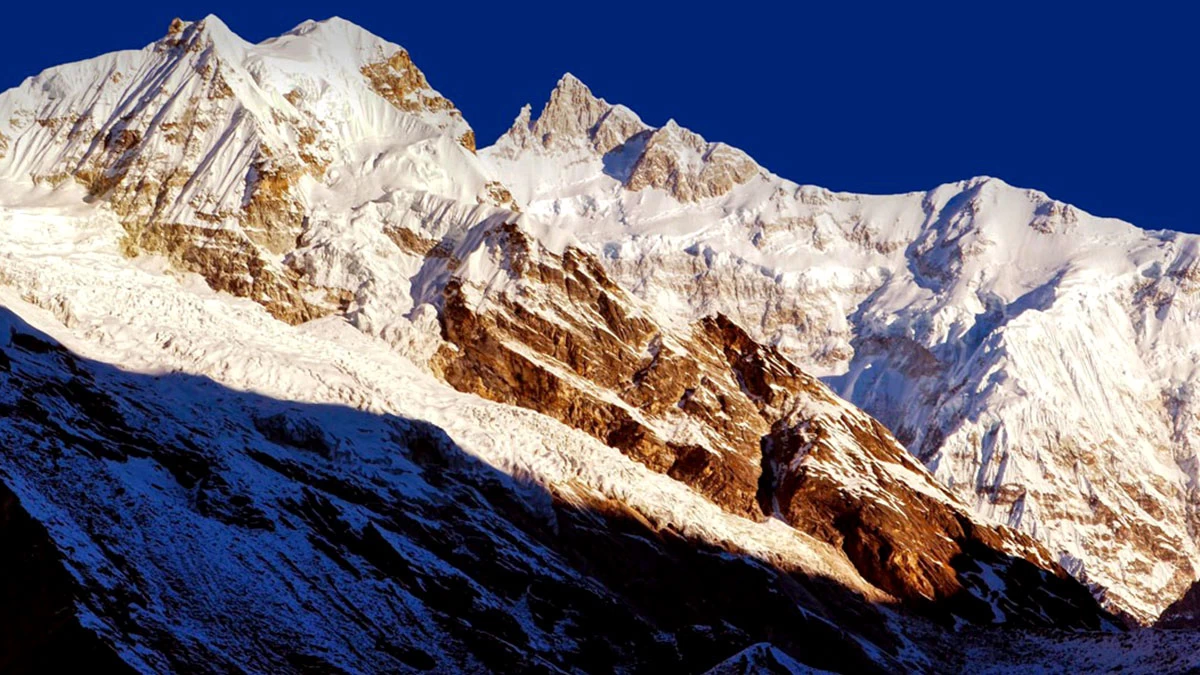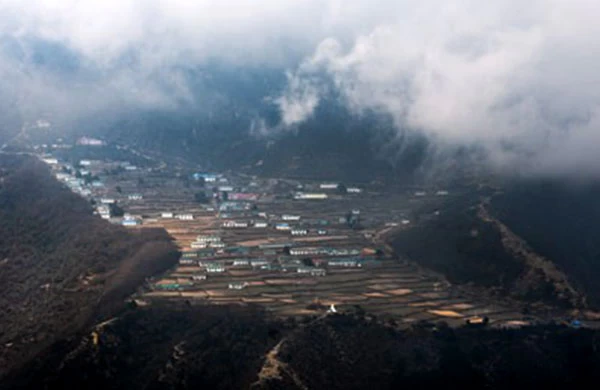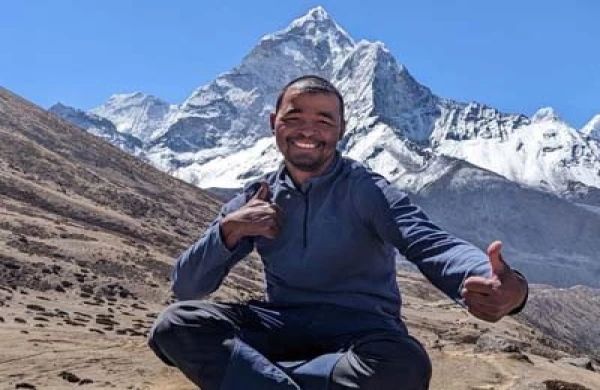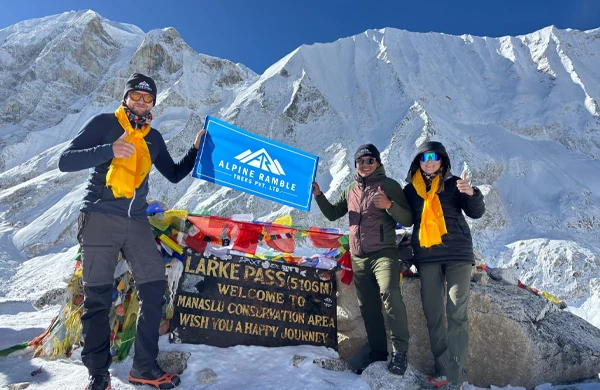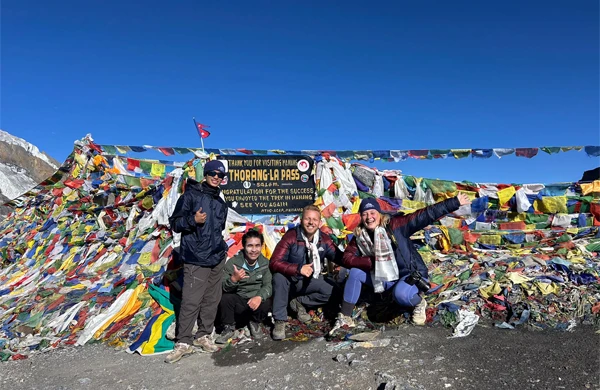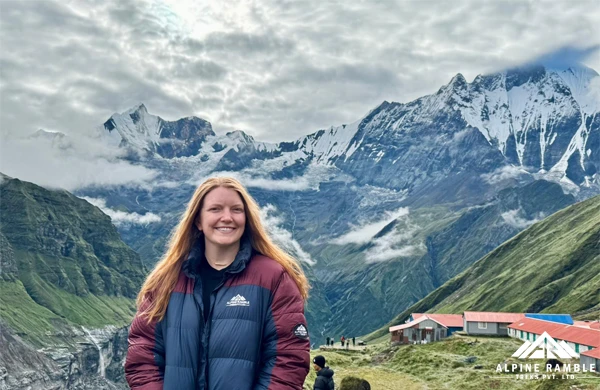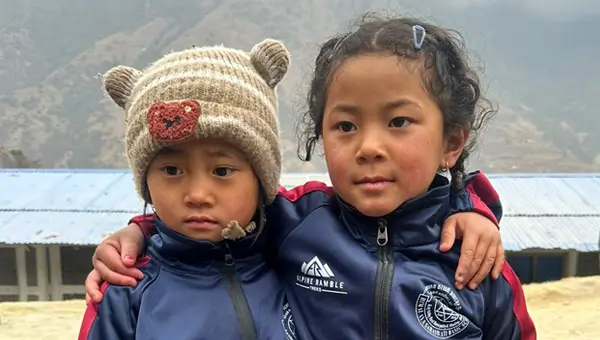Venture into the far east of Nepal, where the mighty Kanchenjunga towers above the snowbound peaks of the surrounding Himalayas. The massive bulk of the world’s third-highest mountain sprawls across two different countries, reaching over the border of Nepal to touch the Indian state of Sikkim.
Locally, the mountain is known to embody the Five Treasures of Snow. While modern trekkers are inclined to attribute this nickname to the mountain’s five distinct peaks, folklore reveals a more nuanced origin: the five treasures actually represent gold, silver, gems, holy texts, and grain.
The lore of this fabled mountain spans generations of history: Kanchenjunga is a mountain rife with myth and legend, home to stories of both demons and mankind’s own origins.
When you embark upon your own Kanchenjunga trek, you’ll be entering a sacred Himalayan environment—in fact, serious climbers have long been prohibited from setting foot on the mountain’s actual summit.
Fortunately, there are few restrictions to trekking in the region, and Alpine Ramble Treks has developed a number of unforgettable hiking adventures that will introduce you to all the wonders of eastern Nepal.
Trekking in Nepal usually involves venturing far from the beaten path, visiting remote villages, and ascending to high-altitude mountain passes where colorful Buddhist prayer flags snap in the brisk alpine wind—and the Kanchenjunga trek offers all this and more.
While you’ll want to spend as much time as possible while trekking in Nepal, we’ve prepared a variety of trekking itineraries for your consideration. The most comprehensive hike in the region is undoubtedly the Kanchenjunga Circuit Trek, which takes approximately four weeks.
During this epic trek in the Himalayas, you’ll visit two base camps, pay your respects at ancient monasteries, and climb to higher than 5,000 meters in elevation.
You can also tackle the Kanchenjunga North Trek or Kanchenjunga South Trek separately: each route offers unforgettable experiences in Nepal’s eastern Himalayas.
Of course, if you’re looking for a shorter Kanchenjunga trek, it’s possible to make a round-trip hike to the mountain’s base camp over the course of about one or two weeks. And when you travel with Alpine Ramble Treks, we’ll work with you to develop a customized itinerary designed specifically to meet your needs.
Read on to discover more about trekking in the Kanchenjunga region, and don’t hesitate to contact us with any questions.
How Difficult is the Kanchenjunga Trek?
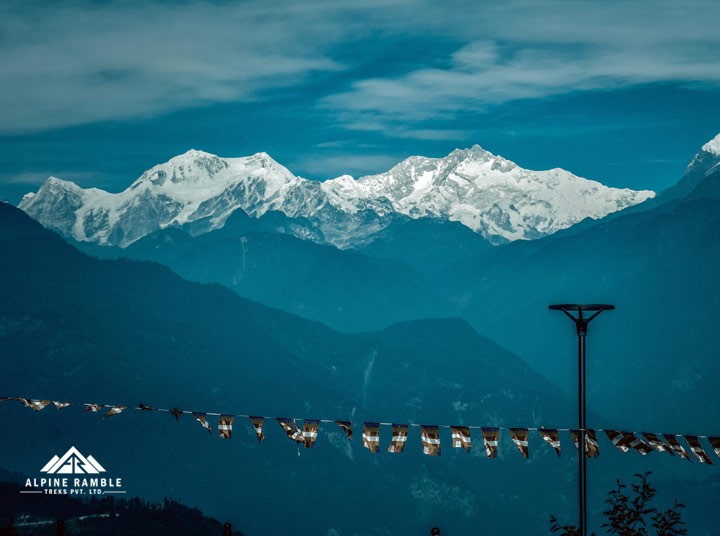
While previous hiking experience isn’t generally necessary to trek in Nepal, you can expect a Kanchenjunga trek to be more challenging.
When compared with popular staples like the Everest Base Camp Trek or Annapurna Base Camp Trek, trekking around Kanchenjunga requires travelers to venture into Nepal’s far east, where teahouses may be comparatively few and far between.
And whether you’ve chosen to complete the entire Kanchenjunga Circuit or one of its shorter loops, trekking around Kanchenjunga usually involves ascending to serious altitude.
You can expect to climb to higher than 5,000 meters in elevation, which is well above the threshold where some climbers may experience symptoms of altitude sickness, or acute mountain sickness.
Common symptoms include headaches, nausea, and lack of appetite. Your physician may recommend certain medications to combat the risk of contracting altitude sickness, but the best cure is always to immediately descend to lower elevations.
Fortunately, your expert guides and porters from Alpine Ramble Treks will be there every step of the way. Our seasoned guides have been trained to shepherd you safely across the Himalayan wilderness, and our itineraries are always built with flexibility in mind.
If you need to trek more slowly or make changes to your trekking route, our guides will handle all of the necessary arrangements. This will leave you free to focus on the real challenge of trekking in Nepal: putting one foot in front of the other.
You’ll be hiking for several hours each day, covering many kilometers of alpine territory as you trek across the slopes of the world’s third-highest mountain. For this reason, we recommend a Kanchenjunga trek to travelers in good physical condition.
The best way to prepare for this adventure is to engage in regular cardiovascular exercise: swimming, running, and walking. With a little preparation, a Kanchenjunga trek is well within the reach of most visitors to Nepal.
Weather in the Kanchenjunga Region
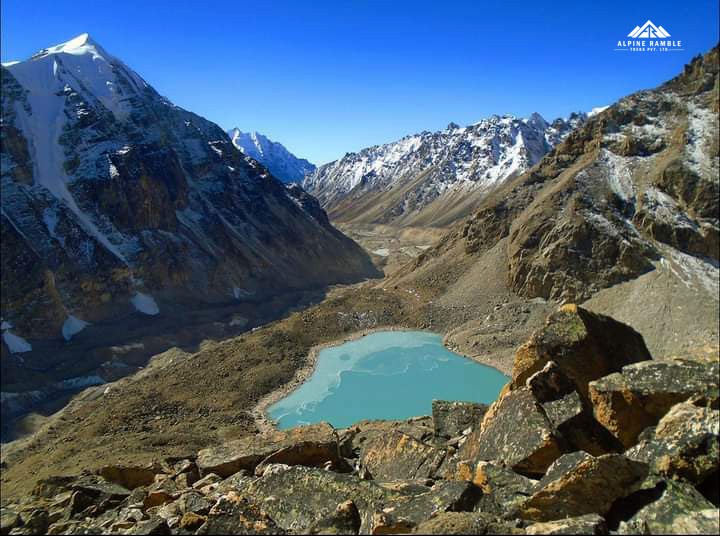
If you’re planning your own trek to Kanchenjunga, you’re probably wondering how weather and climate might impact your adventure in the Himalayas.
The best time for trekking in Nepal is driven by the country’s seasonal monsoon, which brings heavy rain to mountain trails during the summer months.
Most visitors, therefore, choose to trek during the springtime months between March and May, as well as the autumn months between September and November. This general maxim holds true for trekking around Kanchenjunga, where you’ll want clear views and pleasant temperatures as you ascend to the region’s many fantastic high-altitude mountain viewpoints.
If you’re trekking during the spring, you can expect to enjoy an unforgettable sight as the foothills of the mountain burst into life with the colorful blooms of rhododendron flowers.
And if you travel to Kanchenjunga during the autumn, you’ll be able to anticipate crowd-free trails decorated with the vivid foliage of the fall season.
While it’s also possible to enjoy a Kanchenjunga trek during the summer months between May and August, eastern Nepal generally experiences more rainfall than the rest of the country.
Rainy conditions can render mountain trails muddy and slippery, making it difficult to reach the high-altitude mountain passes along the Kanchenjunga Circuit. Likewise, we also recommend avoiding the winter season for your Kanchenjunga trek; temperatures will be colder at this time of year, and technical skills may be required to navigate trails impacted by the season’s heavy snowfall.
But don’t worry—if you’re planning a summer or winter holiday in Nepal, Alpine Ramble Treks will be happy to help you put together the itinerary of a lifetime.
There’s no shortage of amazing treks across the entirety of Nepal, and the unique weather systems of the Himalayan mountains mean that you can enjoy a thrilling hike at any time of year. Reach out to us today if you have any questions!
Route and Distances in the Kanchenjunga Region
The length of your Kanchenjunga trek will vary depending on the route that you choose to pursue through the eastern Himalayas of Nepal.
If you intend to follow the entire Kanchenjunga Circuit on an epic hike across the country’s most scenic mountain landscapes, you can expect to cover more than 200 kilometers in distance.
If you elect to tackle the Kanchenjunga North Trek or Kanchenjunga South Trek separately, your trek will be significantly shorter—but you’ll still reach a maximum elevation of greater than 5,000 meters in altitude.
All told, you can expect to spend anywhere between one and four weeks trekking around Kanchenjunga.
To get an idea of the length and breadth of the landscapes you’ll explore during this unforgettable trek in Nepal, we’ve prepared a sample itinerary that encapsulates the entire Kanchenjunga Circuit Trek:
Day One: Arrive in Kathmandu
Day Two: Explore Kathmandu
Day Three: Fly from Kathmandu to Biratnagar
Day Four: Fly from Biratnagar to Taplejung, then trek to Mitlung
Day Five: Trek from Mitlung to Chirwa
Day Six: Trek from Chirwa to Sakathum
Day Seven: Trek from Sakathum to Amjilosa
Day Eight: Trek from Amjilosa to Gyabla
Day Nine: Trek from Gyabla to Ghunsa
Day 10: Explore Ghunsa
Day 11: Trek from Ghunsa to Khambachen
Day 12: Explore Khambachen
Day 13: Trek from Khambachen to Lhonak
Day 14: Trek from Lhonak to Pang Pema, then return to Lhonak
Day 15: Trek from Lhonak to Ghunsa
Day 16: Trek from Ghunsa to Sele La
Day 17: Trek from Sele La to Tseram
Day 18: Trek from Tseram to Ramche, then return to Tseram
Day 19: Trek from Tseram to Lamite Bhanjyang
Day 20: Trek from Lamite Bhanjyang to Yamphudin
Day 21: Explore Yamphudin
Day 22: Trek from Yamphudin to Yangpang
Day 23: Trek from Yangpang to Thorpu
Day 24: Trek from Thorpu to Birtamod
Day 25: Drive from Birtamod to Bhadrapur, then fly to Kathmandu
Day 26: Explore Kathmandu
Day 27: Departure
As you peruse this sample itinerary, you may have noticed that we’ve reserved several days to explore some of eastern Nepal’s remote alpine communities.
While these towns and villages will undoubtedly reward the time you spend to get acquainted with them, these days actually serve another purpose: to acclimatize your body to the increased altitude of the Himalayas.
As we ascend higher and higher into the mountains, we’ll need time to adjust to the rarefied air. This is especially important when trekking in the far-flung, high-altitude villages of the Kanchenjunga region.
Fortunately, your rest days will be spent in comfort when you’re trekking in Nepal. Read on to learn more about the accommodations you can expect while trekking in the Kanchenjunga region.
Accommodations on the Kanchenjunga Trek
The remote wilds of Nepal’s eastern Himalayas have long appealed to travelers seeking rugged adventures in the heart of the mountains.
For years, the only accommodations available here in the Kanchenjunga region were those that you carried in with you—in other words, tents and basic camping facilities. While there’s a certain undeniable appeal to sleeping under canvas with the alpine heights of the Himalayas towering far above your head, we’re happy to report that teahouse accommodations are now available on many of our best Kanchenjunga treks.
On your next trek to this part of Nepal, you can come in from the cold and enjoy our country’s famous hospitality. Teahouses on the Kanchenjunga Circuit and other hikes in the region now represent a comfortable, affordable alternative to roughing it in the Himalayas.
When you stop at each lodge on the Kanchenjunga trek, you can expect clean rooms, a central dining hall heated with a fire or stove, and tasty home-cooked meals. Shower facilities are likely to be rather basic—but as with many treks in Nepal, sometimes a bucket of warm water is all you need after a long day on the trail.
Likewise, Wi-Fi and cellular signals may be few and far between. While you may be able to pay a small fee to access them at certain points during your Kanchenjunga trek, we recommend allowing yourself to disconnect from the demands of the modern world.
Your trek in Nepal will be all the more memorable if you fully immerse yourself in the natural splendor of the Himalayas and focus on the present moment—especially when trekking around the world’s third-highest mountain.
Meals on the Kanchenjunga Trek
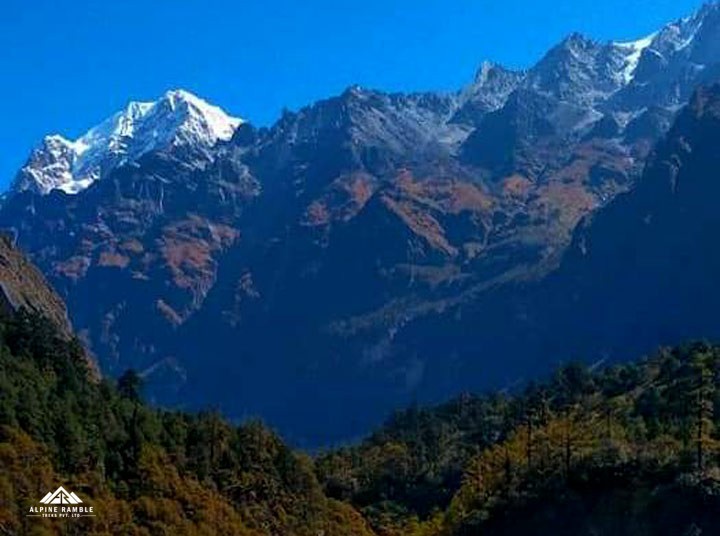
When trekking in the Himalayas, you’ll need plenty of calories to energize your body. While it may be possible to obtain meat-based dishes at lower altitudes, the residents of the Kanchenjunga region are largely vegetarian.
This means you can expect to enjoy tasty, simple fare that’s both plentiful and filling—and trekking in Nepal wouldn’t be the same without the ubiquitous dal bhat. This common dish is comprised of lentil soup served with rice, curried vegetables, and pickles—and it’s typically served in an all-you-can-eat fashion.
This is an inexpensive way to fill your stomach and maintain your energy as you trek in the Himalayas. In fact, there’s a saying here in Nepal: dal bhat power, 24 hours! When you trek in the Kanchenjunga region, you’ll quickly come to understand the value of this common sentiment.
If by chance you’ve had your fill of dal bhat, other trekking staples can also be found on the Kanchenjunga Circuit: Tibetan bread, thukpa noodle soup, momos, and the occasional Western-style dish are common to most teahouse menus.
You’ll also have your choice of beverage to accompany your meals. While we generally recommend avoiding alcohol and large amounts of caffeine when trekking at high altitudes, there are plenty of teas to try during your Kanchenjunga trek.
One local delicacy is butter tea: prepared with yak butter and cut with salt, it’s something of an acquired taste—but it’s a classic Himalayan recipe that you won’t want to miss.
What Should You Pack for your Kanchenjunga Trek?
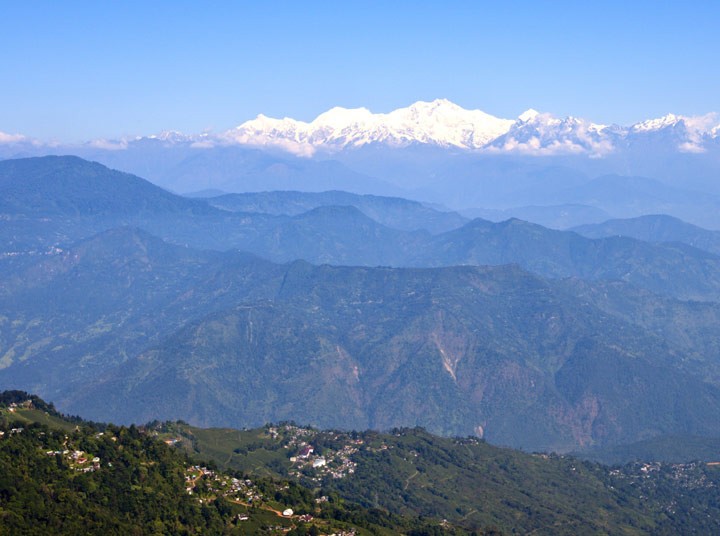
Not sure what to pack for your expedition into the Kanchenjunga region? Never fear—Alpine Ramble Treks has led countless successful treks into eastern Nepal, where the world’s third-tallest mountain towers above the glacial rivers and wooded valleys of this spectacular landscape.
While this trek is more remote than most, it nevertheless shares certain essentials with all other treks in Nepal. You can count on Alpine Ramble Treks to provide the basics for you: warm sleeping bags, comfortable down jackets, roomy duffle bags, and sturdy trekking poles.
However, you’ll also need to pack some gear of your own. Here are some suggestions to make your Kanchenjunga trek as seamless as possible:
Hiking boots: it’s important to choose durable, waterproof boots that fit well—just make sure they aren’t too heavy. You’ll be hiking for several hours each day, so you’ll want to break in your new boots and ensure they’re comfortable before arriving in Nepal.
Trekking shirts and trousers: long sleeves are best to protect you from the intense sunlight in the mountains, especially as you reach higher altitudes. Consider lightweight, sweat-wicking clothing that will keep you warm and dry.
Hats and sunglasses: whether you’re trekking in summer or winter, you’ll need a good hat. It’ll keep you shaded during the summer and warm during the winter. Likewise, a good pair of polarized sunglasses shields your eyes from sunlight and bright snow.
Personal toiletries and first aid: When traveling with Alpine Ramble Treks, your guide will always bring critical first aid supplies in case of injury. But it never hurts to carry a small kit, and you’ll need to bring any essential personal medications with you, too. Consider packing a small stash of toilet paper and any unique hygiene products you might need when you’re out in the wilderness of the Kanchenjunga region.
Of course, these are just the essentials necessary for any good trek in Nepal. You’ll also want to consider bringing your camera, sufficient cash for small purchases, and any books or movies you need to stay entertained on your long international flight to Nepal.
And while cellular service may be limited in the mountains of the Kanchenjunga region, you’ll also want to bring your mobile phone. If you have any other questions about what you should pack for your trek in Nepal, don’t hesitate to reach out to us today.
Conclusion
From its icy summit to its evergreen foothills, the mighty Kanchenjunga represents a powerful draw for travelers seeking adventure in the remote Himalayas.
While you can embark upon any number of unforgettable treks in Nepal, an expedition on the Kanchenjunga Circuit will reward you with the memories to last a lifetime.
The local folklore, friendly residents, and scenic views surrounding the world’s third-highest mountain are nothing short of remarkable.
And while we hope that our complete guide to the Kanchenjunga trek has helped you to learn about the highlights of this incredible adventure, we’re also standing by to answer any questions you might have about trekking in Nepal. To get in touch with us, send us an email or call us on WhatsApp at +977 9851175531. We can’t wait to hear from you!

